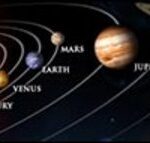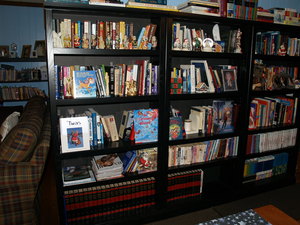Have you seen any of those cool YouTube videos which compare the size of the Earth with the other planets, the Sun and then even larger Stars? Here’s a few to try out:
These videos deal with the relative sizes of the objects in our Solar System (and beyond) but what I want to help you understand today is how far the planets really are from the Sun and from each other by taking a walk. The diagrams that you often see in textbooks just don’t give you an accurate picture of these distances. The idea for how to take a “Planet Walk” comes from a guy named Guy Ottewell and his excellent in-depth description of the Thousand -Yard Model and The Earth as a Peppercorn.
I would like to encourage you to actually do the walk, not just read about it! I have done these walks many times with my Kenmore Junior High Earth Science students and have noticed something new every time. We began up on our athletic field and ended up walking around the field and the entire school for about 50 minutes, fortunately the length of one class. You will need some round objects to be the Sun and the 8 planets: an 8 inch diameter ball, two straight pins, two peppercorns (ask your Mom), a chestnut or large marble about .9 inches in diameter, a hazelnut and a couple shelled peanuts or coffee beans. You might want to tape each object to a white index card so you can pick them up later. Put everything but the ball in a zip-lock bag, wear comfortable shoes, and let’s begin. Optional: if you have a set of fact cards about the Solar System, throw these in your bag, too.
The Sun and Mercury
Begin your walk at a spot where you can go at least 100 yards in a straight line. A football field is great as long as no one is playing on it! Set the ball down at one end of the field: this is your “Sun,” our very own star, and the center of our Solar System. Take turns reading a few interesting facts about the Sun from your fact card. Look carefully at the size of the ball. Then take 10 yard-long (giant steps) away from the Sun and stop, putting down one of the cards with a pin on it. The pinhead is Mercury. What do you know about the closest planet to the Sun? In 2008 NASA got some fabulous new pictures recently from a fly-by. Read a few facts, and then take 8 more steps away from the Sun to Venus, the hottest planet (yes, hotter than Mercury!).
Venus
The Russians sent an unmanned (fortunately!) spacecraft to Venus and it melted and collapsed about 15 minutes after it landed! Put a card with one of the peppercorns on the ground to represent Venus. The thick, carbon dioxide atmosphere makes Venus’s Greenhouse Effect go wild. NOT a nice place to visit! We often see it look so beautiful in the sky, though – thus the flattering name for our “Morning or Evening Star” which is really a planet, not a star.
Earth and Moon
Take 7 more big steps away from the Sun and put your second peppercorn card on the ground. Right! Venus and Earth are about the same size. Take a look back at the Sun and notice its size now. It actually looks about as big as our real Sun does from Earth!
Point out a spot about 2.4 inches from the Earth: this would be where the Moon orbits around the Earth. My “Aha!” came when realizing that this relatively “tiny” distance is the farthest that humans have ever traveled into Space! The Moon is about a quarter the size of Earth.
Mars
Walk 14 more steps and you will arrive at Mars. Do you see why a manned trip to Mars would be a lot more difficult than previous trips just to the Moon? It’s a lot farther away! Share some facts from your Mars fact card and maybe pass out some mini-size Mars bars to give you energy for the rest of the trip! You’ve only just begun!
Jupiter
Take 95 big steps to Jupiter. And put the chestnut/marble card down. You’ll probably be off the field at this point, so make sure you are aimed in a direction where you can either continue walking away from the Sun. or make a big loop in another direction if necessary. Remind everyone with you that you actually should still be walking away from the Sun, even if you have to turn a bit. By the way, did you notice the asteroid belt between Earth and Jupiter? Don’t get hit!
Saturn is another 112 paces past Jupiter. Put the hazelnut down here.
Uranus is another 249 (!) paces past Saturn. One of the peanut cards shows its size.
And you will need to take another 281 giant steps to get to our outermost planet, Neptune, also a peanut.
If you continued on to Pluto, now considered a dwarf planet along with Eris, a recently discovered dwarf planet larger than Pluto, you would walk another 242 steps. This distance is approximate, because Pluto’s orbit is irregular and sometimes Pluto is closer to the Sun than Neptune! Pluto would be even tinier than a pinhead!
You have now completed your Planet Walk. Do you see now why it’s so hard to put a diagram of the Solar System on a couple of textbook pages, let alone one?
Astronomers use a measure of distance called a “light year”, which is how far light travels in a straight line in one Earth year. Using our same scale, a light year would be a thousand miles – not steps, miles! The nearest star to our Sun is Proxima Centauri, which is 4.22 light years from the Sun. This would be over 4000 miles from wherever you are doing your Planet Walk!
Sources
http://www.noao.edu/education/peppercorn/pcmain.html#numbers
Many thanks to retired Shoreline School District teacher, Wendy Borton, from Lake Forest Park, Washington, who took my kids and me on our first Planet Walk and on several stargazing adventures! You got me hooked!






